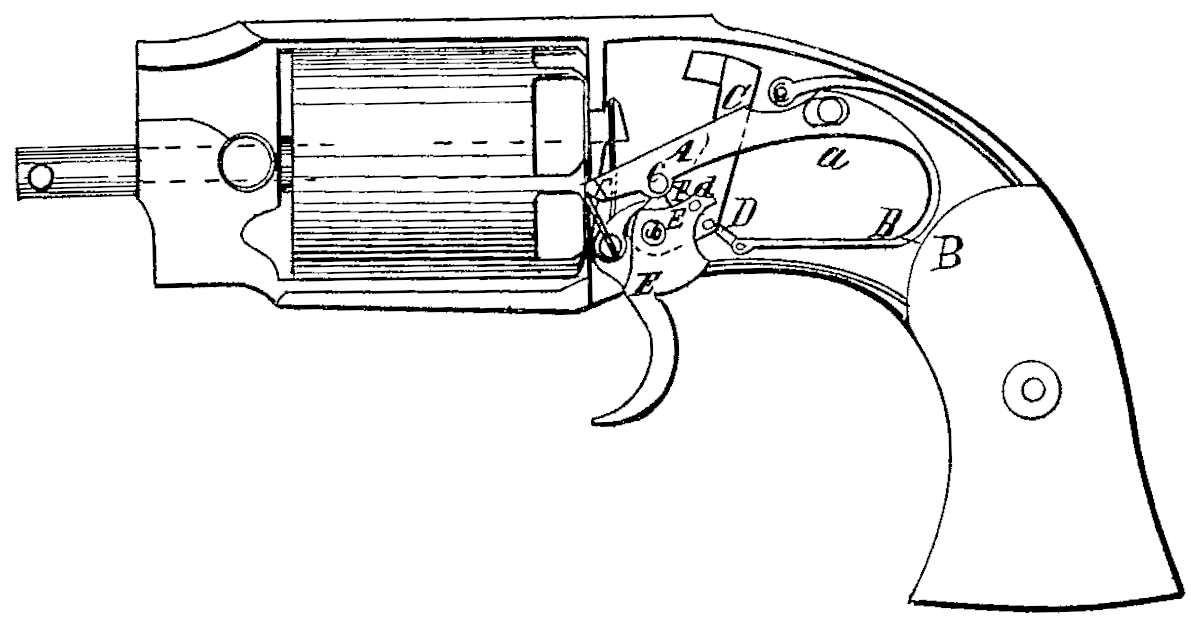US 36861
UNITED STATES PATENT OFFICE.
HENRY S. ROGERS, OF WILLOW VALE, NEW YORK.
IMPROVEMENT IN REVOLVING FIRE-ARMS.
Specification forming part of Letters Patent No. 36,861, dated November 4, 1862.
To all whom it may concern:
Be it known that I, Henry S. Rogers, of Willow Vale, in the county of Oneida and State of New York, have invented a new and useful Improvement in Revolving Fire-Arms; and I do hereby declare that the following is a full, clear, and exact description of the same, reference being had to the accompanying drawing, forming part of this specification, said drawing representing a side view of a pistol with my improvement, leaving the plate which covers the lock removed to show the interior thereof.
On the 22d day of July, 1856, C. S. Pettengill obtained Letters Patent for the invention of certain improvements in revolving fire-arms; and on the 27th of July, 1858, E. A. Raymond and C. Robitaille obtained Letters Patent for the invention of certain improvements in the aforesaid invention of C. S. Pettengill. In a fire-arm constructed according to either of these inventions the necessary tension is brought upon the mainspring to produce the blow of the hammer by the force applied to the trigger in the act of drawing it to fire through the agency of a lever operated upon by a cam on the trigger. Owing to the manner in which the force is transmit ted by the aforesaid cam, the pull on the trigger requires to be harder as the tension of the spring increases. The principal object of this invention is to overcome this difficulty and to obtain a constantly-increasing application of power upon the lever to counterbalance the increasing tension of the spring without requiring a corresponding increase in the force applied to the trigger; and to this end it consists in effecting the connection between the trigger and lever by means of a toggle arranged and applied as hereinafter specified.
A is the lever, and B. the main spring, made in one piece and working upon a fixed pin, a, which constitutes the fulcrum of the lever.
C is the hammer; D, the stirrup-connection between the hammer and mainspring; and E is the trigger working on the same pivot, b, as the hammer. All of these parts are arranged as described and represented in the drawings of the aforesaid patent of Raymond and Robitaille. The trigger E has formed upon its up per part a horn, E’, which is connected by a link, F, and pins c d with the lever, A, in such manner that the said horn and link form a toggle, of which the horn E’ is the lower link and the pin d is the joint-pin. The said horn E; and the link F. are so arranged that when the trigger is left free the horn E’ has a considerable. backward inclination from the pivot b, and the link F has a considerable back ward inclination from the pin c, which connects it with the lever A, the toggle E’ F having then its greatest flexure. The pull on the trigger E to cock and let off the hammer brings the trigger to an upright position and straight, or nearly straight, condition, and hence the toggle is caused to act with a constantly increasing effect on the lever A as the strain or tension which it produces in the spring B increases, thereby enabling the necessary action on the lever to be produced by the trigger with a uniform application of force to the trigger, or without the necessary increase of force which has made the pull on it so hard when it was transmitted to the lever by a cam.
Besides rendering the pull on the trigger much easier, my improvement has the following advantages, viz: First, by making a positive connection between the lever and trigger the difficulty which has been sometimes experienced, when the lock has become foul by use, of the lever hanging or lodging upon the points of the revolving ratchets of the cylinder is obviated; and, second, the proper adjustment of the parts to raise the dog f on the front end of the lever A to the proper height to cause the revolution of the cylinder to the proper position for discharge is rendered more certain.
What I claim as my invention, and desire to secure by Letters Patent, is—
Combining the trigger with the lever A by means of a toggle, E’ F, applied and arranged to operate substantially as herein specified.
HENRY S. ROGERS.
Witnesses:
Amos Rogers,
Chas. D. Rogers.

